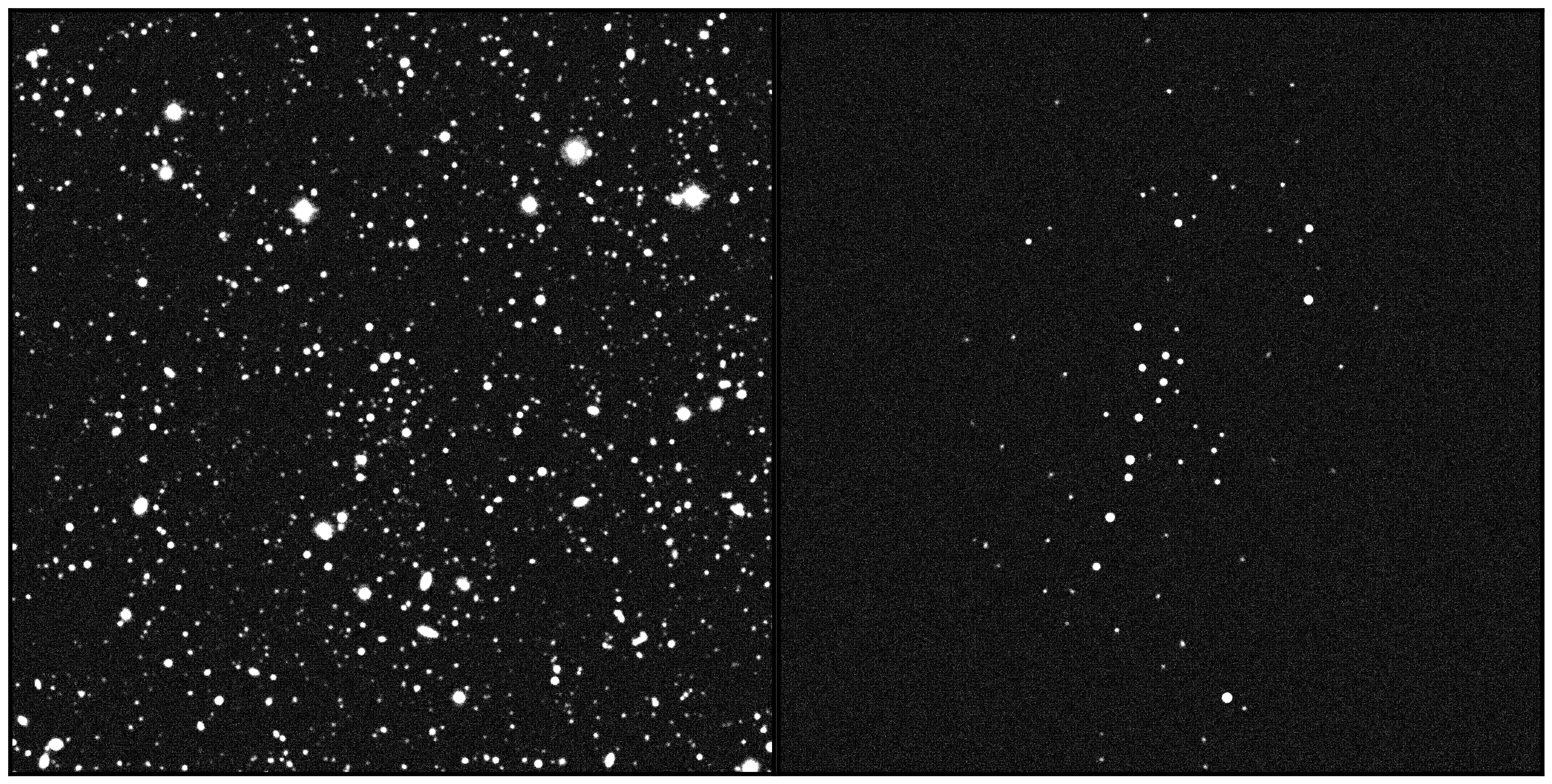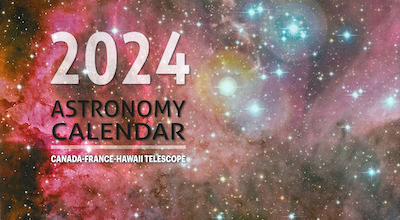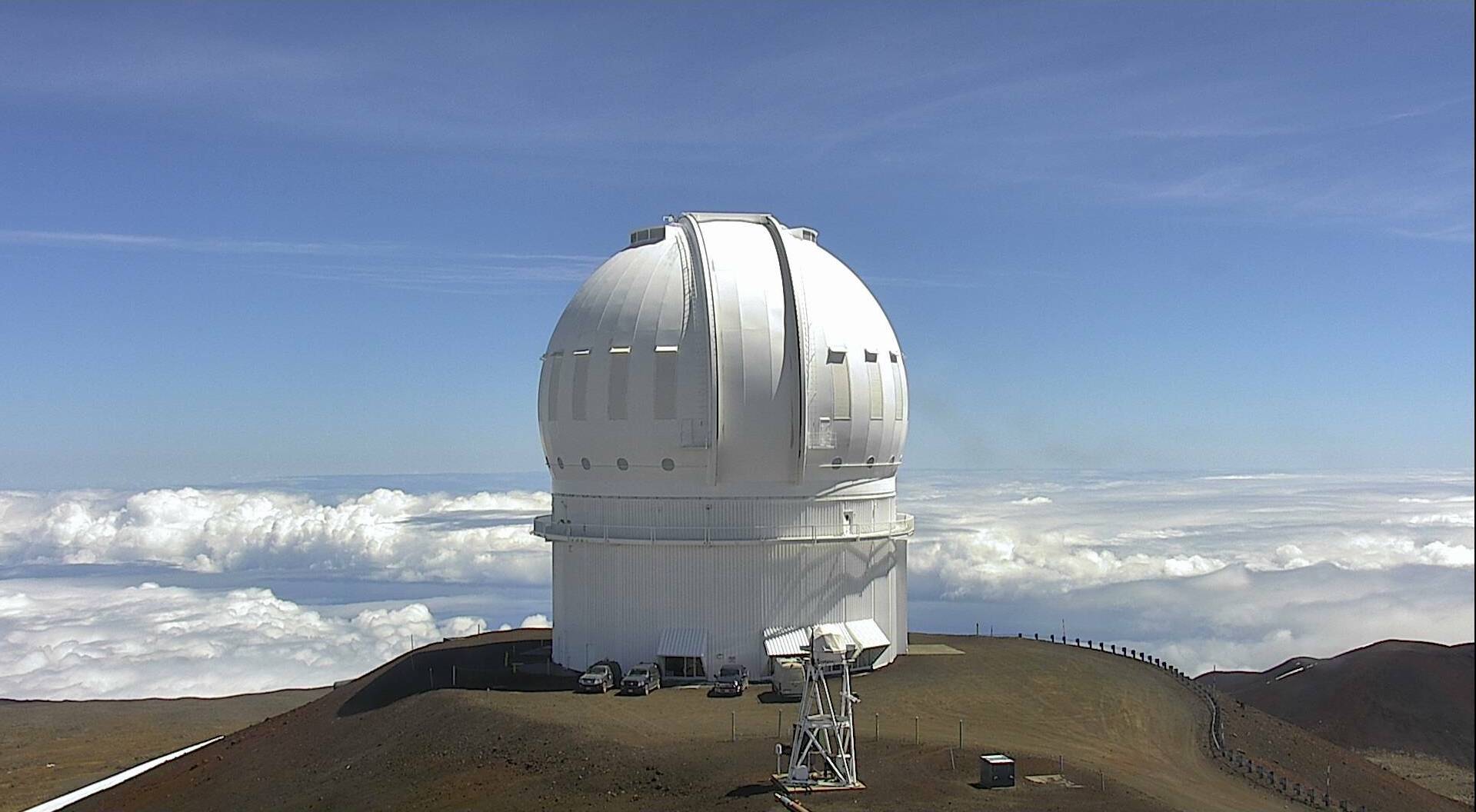New Frontiers in Multi-Messenger Astronomy
CFHT Explores New Frontiers in Multi-Messenger Astronomy
Using MegaCam, the Canada-France-Hawaii Telescope (CFHT)’s imaging instrument, a Canadian-led team of researchers placed one of the tightest limits to date on the light produced by the first observed high-probability merger between a neutron star and a black hole.
On 14 August 2019, a gravitational wave signal was detected by both the Laser Interferometer Gravitational-wave Observatory (LIGO) and its European counterpart Virgo. This signal was likely produced by the last moments of the in-spiral of a neutron star and its companion black hole, followed by the merging of the two objects. The gravitational waves – ripples in the fabric of spacetime itself – created by the merger travelled almost 900 million light years before reaching the two LIGO detectors in Hanford, Washington and Livingston, Louisiana and the Virgo detector near Pisa, Italy. This type of signal is aptly named a “chirp.” Gravitational waves cannot be observed by conventional telescopes that detect light, but can be detected by the specially designed LIGO and Virgo interferometers.
The detected signal, named GW190814, was one of the strongest gravitational wave signals ever received. The odds of the detection being a false alarm are incredibly remote: 1 in 10 ^25 years, or 1 in a million, billion times the age of the Universe. The LIGO-Virgo collaboration traced the event to a region in the sky of about 27 square degrees – approximately the size of a fist held at arm’s length – and promptly announced their detection so astronomers using conventional telescopes could join the observations.
“The merger between a neutron star and a black hole, the most exciting scenario for this case of GW190814, sits at a new frontier in astronomy” said Nicholas Vieira, lead author on the new paper. “Events like GW190814 can be ‘multi-messenger’, in which we learn about the detailed astrophysics of the merger by linking one cosmic messenger, the gravitational waves detected by LIGO and Virgo, to another cosmic messenger, in this case the light we can observe with a telescope like CFHT.”
During the merger of a pair of neutron stars or a neutron star and a black hole, the violent tides in the system tear apart one or both of the neutron stars and fling away extremely neutron-rich material. This neutron-rich material produces radioactive forms of the heaviest elements, including gold and platinum. Neutron star mergers may be the dominant site for the production of these heavy elements across the Universe. These elements radioactively decay, powering a rapidly-evolving, short-lived event called a kilonova. Kilonovae typically reach their peak brightness in visible light within ~2 days of the merger and in the infrared over the next 5 - 10 days. The first and only unambiguous kilonova to-date was observed on 17 August 2017 in the landmark binary neutron star merger GW170817
Vieira, John Ruan (PI of the CFHT program), Daryl Haggard of McGill University, and Maria Drout of University of Toronto led this new campaign to try and nail down an electromagnetic counterpart to the gravitational waves with CFHT’s MegaCam. The team started their observations less than two days after the detection of gravitational waves and continued up to nine days after the detection. They took advantage of MegaCam’s large field of view of ~1 square degree to tile the region of the sky with a 50% probability of finding the gravitational wave source and used targeted observations of known galaxies in the 90% probability region to search for a kilonova event. Owing to the excellent depth reached by CFHT and the large field of view of MegaCam, these observations are among the deepest and most useful searches for a counterpart to GW190814 to-date.
No such optical counterpart was discovered by the authors or any other teams. However, the depths achieved by CFHT MegaCam’s exquisite images can be understood as upper limits on the brightness of a kilonova. These limits on the brightness of the source can then be translated into limits on the amount of material which was swallowed by the black hole and the amount which escaped this fate. The team was able to use their observations to calculate the mass that escaped to be less than 0.04 solar masses, or less than 4% the mass of the Sun. For a typical neutron star, which has a mass around 1.4 times that of the Sun, this means that at least 97% of the star was immediately swallowed by the black hole. This mass limit, which is the strictest presented to date, tells us that the neutron star companion must have been almost or completely gobbled up by the black hole. Alternative explanations, such as the possibility that the lighter object in the merger was not in fact a neutron star but actually a very low-mass black hole, are also being considered. Ultimately, an announcement from the LIGO-Virgo collaboration on the details of GW190814, expected later this year, may help settle these questions. The insights of LIGO-Virgo and CFHT MegaCam observations in conjunction are much more than the sum of their parts.
“While the team didn’t detect an optical counterpart to this event, their follow-up observations show the importance of wide field cameras like MegaCam in this new era of multi-messenger astronomy” said Daniel Devost, director of science operations at CFHT. “We look forward to CFHT playing a leading role in this new exploration of the Universe in the coming years”.
The team involved institutions from Canada and the United States.
Additional information
Media Contact:
Mary Beth Laychak
Canada-France-Hawaii Telescope
808-885-3121
laychak@cfht.hawaii.edu
Science Contact
McGill Space Institute
McGill University
nicholas.vieira@mail.mcgill.ca





